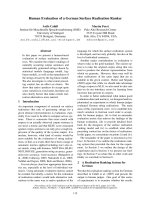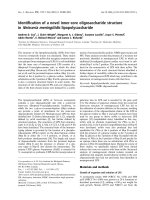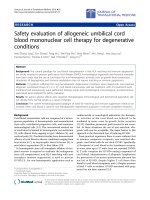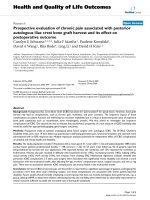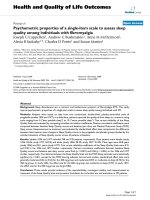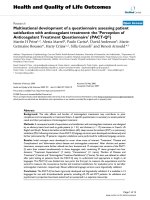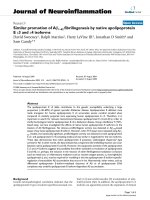Báo cáo hóa học: " Pharmacokinetic evaluation of a 1,3-dicyclohexylurea nanosuspension formulation to support early efficacy assessment" docx
Bạn đang xem bản rút gọn của tài liệu. Xem và tải ngay bản đầy đủ của tài liệu tại đây (249.83 KB, 6 trang )
NANO EXPRESS
Pharmacokinetic evaluation of a 1,3-dicyclohexylurea
nanosuspension formulation to support early efficacy assessment
Jan L. Wahlstrom Æ Po-Chang Chiang Æ
Sarbani Ghosh Æ Chad J. Warren Æ Steve P. Wene Æ
Lesley A. Albin Æ Mark E. Smith Æ Steven L. Roberds
Received: 29 January 2007 / Accepted: 9 May 2007 / Published online: 12 June 2007
Ó to the authors 2007
Abstract Time and resource constraints necessitate
increasingly early decisions to advance or halt pre-clinical
drug discovery programs. Early discovery or ‘‘tool’’
compounds may be potent inhibitors of new targets, but all
too often they exhibit poor pharmaceutical and pharma-
cokinetic properties that make early assessment of in vivo
efficacy difficult. 1,3-Dicyclohexylurea, a potent and
selective inhibitor of soluble epoxide hydrolase (sEH),
reduces blood pressure in hypertensive preclinical animal
models when administered intraperitoneally using DMSO/
corn oil as a delivery vehicle. However, the poor aqueous
solubility of DCU poses a challenge for in vivo dosing in a
multiple dose situation. Therefore, we developed a nano-
suspension formulation of DCU to support oral, intrave-
nous bolus and intravenous infusion dosing. Use of the
nanosuspension formulation maintained DCU free plasma
levels above the sEH IC50 and demonstrated that the
application of formulation technology can accelerate
in vivo evaluation of new targets by enabling pharmaco-
dynamic studies of poorly soluble compounds.
Keywords Nanosuspension Á Formulation Á
Pharmacokinetics Á Efficacy Á Tool compounds
Abbreviations
CYP Cytochrome P450
Introduction
The pharmaceutical industry has increasingly adopted a
programmatic fail-fast/fail cheap paradigm in an effort
reduce costs and deploy resources in an efficient manner
[1]. Early assessment of the pharmacodynamic response of
a target to drug administration may facilitate an early ‘‘go’’
or ‘‘no go’’ decision for a program based upon results from
an in vivo efficacy model. However, tool compounds or
discovery screening hits often exhibit poor physicochemi-
cal properties, solubility and pharmacokinetic attributes,
making in vivo activity assessment difficult due to low
exposure levels. Formulation-based approaches to improve
exposure to tool compounds, such as the addition of or-
ganic co-solvents, may interfere with the pharmacody-
namic readout of the in vivo model or may not be tolerated
if sustained systemic levels are required, as in the case of a
multiple dose situation [2, 3]. The use of novel biomaterials
and polymeric delivery systems may also be tenable [4, 5],
although these tools are more likely to be applied in a drug
development environment.
Nano and micro particle drug delivery systems have been
applied throughout the pharmaceutical industry, and such
This study was supported by Pharmacokinetics, Dynamics and
Metabolism at Pfizer.
J. L. Wahlstrom (&) Á C. J. Warren Á S. P. Wene Á
L. A. Albin Á M. E. Smith
Pharmacokinetics, Dynamics and Metabolism, Pfizer Global
Research & Development, St. Louis Laboratories, Pfizer Inc.,
700 Chesterfield Parkway West, T312E, Chesterfield, MO
63017, USA
e-mail:
P C. Chiang
Pharmaceutical Sciences, Pfizer Global Research &
Development, St. Louis Laboratories, Pfizer Inc., St Louis, MO,
USA
S. Ghosh Á S. L. Roberds
Molecular Pharmacology, Pfizer Global Research &
Development, St. Louis Laboratories, Pfizer Inc., St Louis, MO,
USA
123
Nanoscale Res Lett (2007) 2:291–296
DOI 10.1007/s11671-007-9063-7
systems have mainly focused on oral, intraperitonel, intra-
muscular, or subcutaneous delivery [6, 7]. The primary
advantage of such delivery systems is to take advantage of
increased surface area to enhance the overall dissolution rate.
For example, oral dosing of nanosuspensions is commonly
used to increase the bioavailability of a compound for which
absorption is controlled by dissolution rate without the
addition of a large amount of organic co-solvents.
The use of nanoparticles in IV formulations for water
insoluble drugs has been studied previously [8–12]. Despite
the use of nano and micro particles for IV injection, utili-
zation of nanoparticles for IV infusion has not been well
characterized. This has limited the use of such technology in
pre-clinical research where prolonged and constant exposure
is needed to validate targets with less-than-ideal tool com-
pounds to enable a data driven decision without significant
upfront investment. Considering these challenges, we
developed a general nanosuspension formulation that mini-
mized organic co-solvent, was easy to prepare and was
applicable to an IV infusion or multiple dose study.
1,3-Dicyclohexylurea (DCU) is a potent inhibitor of
soluble epoxide hydrolase, or sEH [13]. Anti-hypertensive
efficacy following a single dose of DCU has been dem-
onstrated in spontaneously hypertensive rats [14, 15].
Inhibition of sEH by DCU leads to an increase in ep-
oxyeicosatrienoic acids (EETs). EETs are P450-derived
metabolites of arachidonic acid and are well established
regulators of cardiovascular and renal function [16]. EETs
possess vasodiliatory properties that maintain vascular
tone, particularly in the renal [17], mesentery [18] and
coronary arteries [19]. Urea-based compounds, such as
DCU, have been found to be potent and selective inhibitors
of sEH [13].
Since DCU and many of its urea analogs exhibit poor
aqueous solubility, targeted synthetic efforts have been ini-
tiated to increase chemotype solubility [20, 21], and heroic
dose formulations of DCU have been used to study its in vivo
efficacy as a sEH inhibitor [15]. Despite these efforts, the
pharmacokinetic/pharmacodynamic relationship of DCU
plasma concentration to sEH inhibition is not well under-
stood in part due to the poor pharmaceutical properties of
DCU. Considering its poor pharmaceutical properties and its
usefulness as a potent inhibitor of sEH, DCU was a good
candidate for nanosuspension formulation.
Materials and methods
Materials
HPLC grade acteonitrile was obtained from Burdick &
Jackson (Muskegon, MI). All other chemicals used were
purchased from Sigma-Aldrich (St. Louis, MO) and were
of the highest purity available. Lead free glass beads (0.5–
0.75 mm) were purchased from Glenn Mills, Inc (Clifton,
New Jersey).
Nanosuspension preparation
For particle size reduction, an internally developed bench
scale wet milling (micronization) device was used [22]. To
make the stock nanosuspension formulation of (10 mg/mL)
DCU, an appropriate amount of glass beads, and 1% (w/w)
Cremophor EL in phosphate buffered saline (pH 7.4) were
added in a scintillation vial. The mixture was then stirred at
1,200 rpm for a period of 48 h with occasional shaking.
The stock formulation was then harvested and potency,
particle size, and solid-state properties were checked.
Particle size distribution was determined on a Beckman
Coulter LS 230 particle size analyzer using the small vol-
ume accessory (Miami, FL). A polarized intensity differ-
ential scattering (PIDS) obscuration water optical model
was employed. Particle size distribution was computed by
the software using Mie scattering theory. There was no
absorption by DCU at the laser line (750 nm) so the
complex index of refraction was determined by finding the
average refractive index of DCU (1.57) by microscopy.
Index matching fluids from Cargille (Cedar Grove, NJ)
were employed.
Powder X-ray diffraction (PXRD) was carried out using
a Bruker D-8 Advance diffractometer (Madison, WI). The
system used a copper X-ray source maintained at 40 kV
and 40 mA to provide radiation with an intensity weighted
average of (Ka
ave
) 1.54184 A
˚
. A scintillation counter was
used for detection. A Go
¨
bel mirror was used to eliminate
Ka radiation. Beam aperture was controlled using a
divergence slit of 0.6 mm and a primary 4° Soller. After
diffraction, a secondary Soller was used to ensure colli-
mation of the diffracted beams. Data were collected using a
step scan of 0.02° per point with a 1 s/point counting time
over a range of 3–35° 2h. In house fabricated aluminum
inserts or inserts with a Hasteloy sintered filter (0.45 lm)
pressed in the center and held in Bruker plastic sample cup
holders were utilized for all analyses. Dry DCU was run as
received without hand grinding. Suspensions were filtered
onto sintered filters under vacuum. In addition to the
PXRD, thermal gravimetric analysis with simultaneous
differential thermal analysis (TGA/STDA) was used to
ensure no solid form changes. The bulk material was re-
duced from 40 to 0.5 lm with a final D
50
of 0.45 lm. The
solid form of the micronized material was checked by
PXRD and TGA/SDTA. There was no discernable change
in crystal form during the micronization process [22].
For the IV bolus dose, the formulation was prepared by
diluting the stock nanosuspension preparation (10 mg/mL)
with 1% (w/w) Cremophore EL in phosphate buffered
292 Nanoscale Res Lett (2007) 2:291–296
123
saline until the desired concentration was reached. For the
IV infusion dose, the formulation was prepared by diluting
the stock nanosuspension solution (10 mg/mL) to twice the
desired target concentration by diluting with 1% (w/w)
Cremophore EL in phosphate buffered saline and then
further diluting with 1% (w/w) Cremophore EL in phos-
phate buffered saline containing 20% PVP (w/w). Final
solutions were tested for concentration using the analytical
methods described below. The total dissolution time and
risk assessment for the IV formulation was conducted by
measuring the plasma solubility of DCU, particle size of
the nanoparticles and the diffusion coefficient of DCU in
rat plasma. Both Noyes–Whitney and Hixson–Crowell
cube root laws were used in the calculation in a conser-
vative way. The calculation was conducted by assuming
the diffusion layer thickness is close to the mean particle
size and all particles are uniformly sized. The complete
dissolution time for each particle was estimated to be less
than a minute upon injection [22]. The dissolution time was
calculated without the considering the advantage of the
turbulent blood flow in the vein, which should serve to
further reduce the diffusion boundary thickness, rapidly
disperse the initial injection volume and minimize local
concentration effects. Thus, the DCU nanoparticle formu-
lation is expected to have instant and complete dissolution
in the blood upon the IV injection and infusion.
Liquid chromatography/tandem mass spectral analysis
The LC/MS system was comprised of an API 4000 triple
quadropole mass spectrometer with an atmospheric pres-
sure electrospray ionization source (MDS SCIEX, Con-
cord, Ontario, Canada), and two LC-10ADvp pumps with a
SCL-10ADvp controller (Shimadzu, Columbia, MD). A
Thermo Electron Aquasil-C18 column (2.1 · 20 mm,
3.0 l, Waltham, MA) was used for separation with initial
conditions of 10% B, followed by a gradient of 10% B to
90% B over 1 min (solvent A 0.1% formic acid, solvent B
100% acetonitrile), 90% B was held for 0.5 min, followed
by an immediate return to initial conditions that were
maintained for 0.5 min with a flow rate of 0.5 mL/min.
The compounds were detected by an API 4000 triple
quadropole mass spectrometer with an atmospheric
pressure electrospray ionization source (MDS SCIEX,
Concord, Ontario, Canada). Using the positive ion mode,
protonated molecular ions were formed using an ion
spray voltage of 5,000 V, declustering potential of 76 eV,
entrance potential of 10 eV and source temperature of
600 °C for DCU. Using the positive ion mode, protonated
molecular ions were formed using an ion spray voltage of
5,000 V, declustering potential of 86 eV, entrance potential
of 10 eV and source temperature of 600 °C for carba-
mazepine. Product ions formed at a collision energy of
23 eV for DCU (m/z 225.1 fi 100.1) and at a collision
energy of 27 eV for carbamazepine (m/z 237.1 fi 194.3).
Pharmacokinetic study of DCU
Male Sprague–Dawley (SD) rats weighing 250–300 g were
purchased from Charles River Laboratories (Wilmington,
MA) and acclimated to their surroundings for approxi-
mately one week with food and water provided ad libitum.
On the day prior to study animals were anesthetized with
isoflurane (to effect) and then implanted with BASi vas-
cular catheters (West Lafayette, IN) in the carotid artery
and jugular vein. Animals were acclimated in Culex cages
(BASi) overnight prior to dosing. Patency of the carotid
artery catheter was maintained using the ‘‘tend’’ function
of Culex automated blood sampler. For oral studies (sus-
pension dose: 3 mg/kg, n = 3 animals; nanosuspension
dose: 10 and 30 mg/kg, n = 3 animals) were dosed via oral
gavage. For IV bolus (solution dose: 3.0 mg/kg, n =3
animals; nanosuspension dose: 2.5 mg/kg, n = 4 animals)
and infusion studies (nanosuspension dose: 4.3 mg/h/kg,
n = 4 animals), animals were dosed via the jugular vein
catheter. For the IV bolus study, the injection volume was
controlled at 1 lL/g of body weight and for the IV infusion
study the infusion rate was controlled at 1 mL/h for a
period of 3 h. Blood collections were performed by the
Culex at 0.083, 0.25, 0.5, 1, 2, 4, 6, 8, and 12 h time points
for the IV bolus and oral nanosuspension doses. Blood
collection time points for the IV infusion study were 0.25,
0.5, 1, 1.5, 2, 3, 3.5, and 4 h. These animal studies were
approved by the St. Louis Pfizer Institutional Animal Care
and Use Committee. The animal care and use program is
fully accredited by the Association for Assessment and
Accreditation of Laboratory Animal Care, International.
Plasma protein binding measurement
Plasma protein binding measurements were performed
using a 96-well plate equilibrium dialysis method that has
been described previously [
23]. Equilibrium dialysis was
performed using pooled, heparinized rat plasma at a final
DCU concentration of 10 lMat37°C for 4 h.
Pharmacokinetic data analysis
Pharmacokinetic parameters were estimated using Win-
Nonlin Professional
Ò
(version 4.1, Pharsight Corporation,
Mountain View, CA). A two-compartment, first order
model (WinNonlin PK model 7, IV-Bolus) was selected for
pharmacokinetic modeling of the IV bolus concentration
versus time data. A two-compartment, first order model
(WinNonlin PK model 9, IV-Infusion) was selected for
simulation of the IV infusion data. Estimated parameters of
Nanoscale Res Lett (2007) 2:291–296 293
123
V
1
(central volume of distribution, 1285.3 mL), k
10
(elim-
ination rate, 1.62 h
–1
), k
12
(rate of distribution from com-
partment 1 to compartment 2, 0.224 h
–1
), and k
21
(rate of
drug distribution from compartment 2 to compartment 1,
0.166 h
–1
) obtained from modeling the nanosuspension IV
bolus dose were used to simulate plasma concentrations for
the IV nanosuspension infusion experiment.
Results
To examine the PK parameters of commercially available
DCU, we dosed SD rats using 3 mg/kg IV bolus, oral
solution and oral suspension administration methods and
generated corresponding plasma concentration versus time
curves (Fig. 1). The IV bolus treatment exhibited a
biphasic log-linear curve with a prolonged terminal
half-life. The suspension dose exhibited an extended
absorption profile with a T
max
of 2 h and a C
max
of 0.024
lg/mL, consistent with solubility/dissolution rate-limited
absorption.
To determine if reducing DCU particle size would im-
prove compound exposure, a 30 mg/kg oral suspension and
two oral nanosuspension doses (10 and 30 mg/kg) were
administered to SD rats. Plasma concentration versus time
curves for the 30 mg/kg oral suspension and two oral
nanosuspension doses (10 and 30 mg/kg) are shown in
Fig. 2. C
max
values for the 10 and 30 mg/kg nanosuspen-
sion doses were 27- and 35-fold greater than the unmilled
suspension dose, and plasma concentrations were 3.7- and
15-fold higher for the nanosuspension doses at 6 h,
respectively. Thus, nanosuspension formulation produced
more rapid and complete oral absorption of DCU.
If the nanosuspension formulation enabled very rapid
dissolution of DCU, then the pharmacokinetic profile of a
DCU nanosuspension administered by IV should be very
similar to the profile of an IV solution. To address this, a
two-component, first order pharmacokinetics model was
used to fit the plasma concentration–time curve following a
3 mg/kg solution or 2.5 mg/kg nanosuspension IV admin-
istration of DCU (Fig. 3). Pharmacokinetic parameters
were calculated using the WinNonlin pharmacokinetic
software package and are listed in Table 1. The nanosus-
pension and solution-based IV doses exhibited clearance
values of 33.6 and 34.7 mL/min/kg, respectively, and fast
initial half-lives of 0.37 and 0.37 h, respectively. Other
pharmacokinetic parameters (volume of distribution, mean
residence time and elimination half-life) were similar when
comparing the nanosuspension dose (3020 mL/kg, 1.5 and
4.8 h, respectively) to the solution dose (2149 mL/kg, 1.07
and 3.9 h, respectively). These results reinforced the in vi-
tro prediction of the diffusion coefficient and plasma sol-
ubility of the DCU nanosuspension, which indicated that
dissolution would likely take place in less than one minute
[22].
0.0 2.5 5.0 7.5 10.0 12.5
0.005
0.05
0.5
Time (h)
Ccnotnerati ( no
µ
/gml)
Fig. 1 Plasma concentrations of DCU after 3.0 mg/kg IV bolus (—),
oral solution (- - -) and oral suspension (ÁÁÁ) administration. Only the
IV bolus dose reached the in vitro IC50 based on free plasma
concentrations
0 5 10 15 20 25 30
0.001
0.01
0.1
1
10
Time (h)
Ccnotnerati ( no
µ
/gml)
Fig. 2 Plasma concentrations of DCU after 30 mg/kg (—) and
10 mg/kg (- - -) oral nanosuspension and 3 mg/kg (ÁÁÁ) suspension
administration. Free plasma concentrations remained above the
in vitro IC50 for approximately 2 h for the nanosuspension doses
0 1 2 3 4 5 6 7 8 9
0.005
0.05
0.5
5
Time (hr)
Ccnotnerati ( no
µ
/gml)
Fig. 3 Plasma concentrations of DCU after 3.0 mg/kg IV solution
(—) and 2.5 mg/kg nanosuspension (- - -) bolus administration. The
pharmacokinetic profiles for the unmilled and nanosuspension
solutions were similar
294 Nanoscale Res Lett (2007) 2:291–296
123
Despite the greatly improved plasma exposures of the
nanosuspension, the short half-life of DCU limited the
ability to achieve sustained plasma concentrations. An IV
infusion is a practical approach to introduce sustained
levels of compound over a matter of hours, or longer, with
the aid of an implanted pump. To evaluate the predict-
ability of an IV infusion of the DCU nanosuspension, a
two-component, first order pharmacokinetics model was
used to simulate and predict plasma concentration versus
time for a 3-h nanosuspension IV infusion dose based upon
pharmacokinetic parameters estimated from the nanosus-
pension IV dose (Fig. 4). Experimentally determined
plasma concentrations during the infusion phase were
higher than the predicted values, while experimental and
predicted plasma concentration values matched following
termination of the infusion (Fig. 4).
Discussion
Administration of DCU formulated in DMSO/corn oil (3 mg/
kg, interperitoneal dosing) has been demonstrated to lower
blood pressure in the spontaneously hypertensive rat (SHR)
model [15]. However, plasma concentrations were not re-
ported for the experiment. For an initial assessment of phar-
macokinetic characteristics, DCU was administered to
Sprague–Dawley rats at 3 mg/kg using IV, oral suspension
and oral solution formulations. Due to the high plasma protein
binding of DCU (97%), a systemic plasma level of 0.672 lg/
mL was needed to reach the literature-determined IC50 of
DCU (90 nM, 0.020 lg/mL) in terms of free plasma con-
centration [13]. While plasma concentrations above 0.672 lg/
mL were obtained using 3 mg/kg IV bolus dosing, systemic
levels above the IC50 were not maintained for greater than
1 h due to the poor pharmacokinetics profile of DCU. Neither
the oral solution nor the oral suspension doses reached free
plasma levels above the IC50. Comparison of the oral solution
and suspension data indicated that DCU exhibited good per-
meability in vivo and suggested that the extended absorption
phase of the suspension dose was dissolution rate controlled.
Since minimal increases in exposure were obtained by
increasing the suspension dose (up to 30 mg/kg) and the high
organic content of the solution dose (70% PEG) was inap-
propriate for the efficacy model, we turned to micronization
for formulation into a nanosuspension as a potential alterna-
tivetoimprovetheexposurelevelsofDCU.
Due to ease of administration in a multiple dose situa-
tion, oral dosing of the nanosuspension was examined
initially. While both 10 and 30 mg/kg doses of the nano-
suspension reached plasma concentrations surpassing the
free IC50, necessary plasma levels were not maintained for
greater than 2 h. Simulation of the data indicated that tid or
qid dosing would be required to maintain desired plasma
levels. Due to the inconvenience of those dosing regimes
and the desire to minimally disturb the animals for blood
pressure studies, intravenous studies were examined. The
pharmacokinetics profile of a 2.5 mg/kg dose of DCU
nanosuspension closely matched the profile of the IV
solution dose (Fig. 3). The pharmacokinetics results rein-
forced the in vitro-determined diffusion coefficient, plasma
solubility, and complete dissolution time of the DCU
nanosuspension, which indicated that dissolution would
likely take place momentarily upon IV dose. The similarity
in pharmacokinetics profile also suggested that organ
accumulation, a problem often encountered with IV
nanosuspension dosing [7, 24], did not occur. While the IV
formulation was well tolerated, infusion studies were
necessary to maintain needed plasma levels. The consis-
tency observed between solution and nanosuspension IV
formulations supported our modeling and demonstrated
that upon injection, the DCU nanoparticles dissolved
Table 1 Pharmacokinetic parameters of the intravenous solution and
intravenous nanosuspension doses
Parameter Solution
dose (n =3)
Nanosuspension
dose (n =4)
Route Intravenous Intravenous
Target dose (mg/kg) 3.0 2.5
C
0
(lg/mL) 2.5 ± 0.1 2.0 ± 0.2
t
1/2a
(h) 0.4 ± 0.1 0.4 ± 0.1
t
1/2b
(h) 3.9 ± 0.6 4.8 ± 0.9
V
ss
(mL/kg) 2100 ± 130 3000 ± 530
CL (mL/min/kg) 33.6 ± 0.9 35 ± 1.0
MRT (h) 1.1 ± 0.1 1.5 ± 0.4
AUC
0–¥
(lg h/mL) 1.5 ± 0.1 1.2 ± 0.1
Mean AUC
0–¥
(lg h/mL)/dose 0.5 0.5
0 1 2 3 4 5
0
1
2
3
Time (h)
Ccnotnertai ( no µ /gml)
Fig. 4 Plasma concentrations (m) and WinNonlin modeling simula-
tion (- - -) of DCU IV infusion of the nanosuspension. The infusion
data could be modeled based upon the IV bolus data
Nanoscale Res Lett (2007) 2:291–296 295
123
instantaneously and completely in the blood. Otherwise, a
significant change of the pharmacokinetic profile might be
expected.
The infusion study (Fig. 4) maintained free plasma
levels three-fold higher than the in vitro IC50 for a 3-h
period. The studies also indicated that the nanosuspension
infusion pharmacokinetics profile could be predicted with
reasonable accuracy based upon the nanosuspension IV
data. The formulation did not alter blood pressure in nor-
motensive animals over the time of the infusion, and the
animals did not show adverse effects to the formulation.
More importantly, these experiments demonstrated that
nanosuspension formulations can be used to enhance
exposure of compounds with low solubility and poor
pharmacokinetic characteristics for early decision-making
in a drug discovery environment.
Conclusions
One of the biggest hurdles facing the pharmaceutical
industry today is the need to lower costs and move products
to the market in a timely manner. Therefore, early target
validation and assessment without a large up front invest-
ment is becoming critical. The use of nanoparticle paren-
teral drug delivery systems for oral, IV injection and IV
infusion of tool compounds to reach desired exposures
allows researchers to obtain reliable and critical data for
early decision making early in the discovery process
without large investment by utilizing less-than-ideal, pro-
totype compounds for target validation.
References
1. A. Dove, Nat. Biotechnol. 17, 859 (1999)
2. G.A. Brazeau, H.L. Fung, J. Pharm. Sci. 79, 773 (1990)
3. K. Korttila, A. Sothman, P. Andersson, Acta Pharmacol. Toxicol.
(Copenh) 39, 104 (1976)
4. R.S. Langer, N.A. Peppas, Biomaterials 2, 201 (1981)
5. N.A. Peppas, R. Langer, Science 263, 1715 (1994)
6. P. Kocbek, S. Baumgartner, J. Kristl, Int. J. Pharm. 312, 179
(2006)
7. B.E. Rabinow, Nat. Rev. Drug Discov. 3, 785 (2004)
8. M.A. Clement, W. Pugh, I. Parikh, The Pharmacologist 34, 204
(1992)
9. N. Garavilla, E. Peltier, E. Merisko-Liversidge, Drug Dev. Res.
37, 86 (1996)
10. J. Kattan, J.P. Droz, P. Couvreur, J.P. Marino, A. Boutan-Laroze,
P. Rougier, P. Brault, H. Vranckx, J.M. Grognet, X. Morge et al.,
Invest. New Drugs 10, 191 (1992)
11. J.E. Kipp, Int. J. Pharm. 284, 109 (2004)
12. K. Peter, S. Leitzke, J.E. Diederichs, K. Borner, H. Hahn, R.H.
Muller, S. Ehklers, J. Anti. Chemo. 45, 77 (2000)
13. N.R. McElroy, P.C. Jurs, C. Morisseau, B.D. Hammock, J. Med.
Chem. 46, 1066 (2003)
14. J.D. Imig, X. Zhao, C.Z. Zaharis, J.J. Olearczyk, D.M. Pollock,
J.W. Newman, I.H. Kim, T. Watanabe, B.D. Hammock, Hyper-
tension 46, 975 (2005)
15. Z. Yu, F. Xu, L.M. Huse, C. Morisseau, A.J. Draper, J.W.
Newman, C. Parker, L. Graham, M.M. Engler, B.D. Hammock,
D.C. Zeldin, D.L. Kroetz, Circ. Res. 87, 992 (2000)
16. X. Zhao, J.D. Imig, Curr. Drug Metab. 4, 73 (2003)
17. M.A. Carroll, A.B. Doumad, J. Li, M.K. Cheng, J.R. Falck, J.C.
McGiff, Am. J. Physiol. Renal. Physiol. 291, F155 (2006)
18. X. Zhao, A. Dey, O.P. Romanko, D.W. Stepp, M.H. Wang, Y.
Zhou, L. Jin, J.S. Pollock, R.C. Webb, J.D. Imig, Am. J. Physiol.
Regul. Integr. Comp. Physiol. 288, R188 (2005)
19. K.M. Gauthier, E.M. Edwards, J.R. Falck, D.S. Reddy, W.B.
Campbell, Hypertension 45, 666 (2005)
20. I.H. Kim, F.R. Heirtzler, C. Morisseau, K. Nishi, H.J. Tsai, B.D.
Hammock, J. Med. Chem. 48, 3621 (2005)
21. I.H. Kim, C. Morisseau, T. Watanabe, B.D. Hammock, J. Med.
Chem. 47, 2110 (2004)
22. P.C. Chiang, J.L. Wahlstrom, J.G. Selbo, S. Zhou, S.P. Wene,
L.A. Albin, C.J. Warren, M.E. Smith, S.L. Roberds, D.K. Pretzer,
J. Exp. Nanosci. 2, 147 (2007)
23. M.J. Banker, T.H. Clark, J.A. Williams, J. Pharm. Sci. 92, 967
(2003)
24. B. Bittner, R.J. Mountfield, Curr. Opin. Drug Discov. Dev. 5,59
(2002)
296 Nanoscale Res Lett (2007) 2:291–296
123
![Tài liệu Báo cáo khoa học: Specific targeting of a DNA-alkylating reagent to mitochondria Synthesis and characterization of [4-((11aS)-7-methoxy-1,2,3,11a-tetrahydro-5H-pyrrolo[2,1-c][1,4]benzodiazepin-5-on-8-oxy)butyl]-triphenylphosphonium iodide doc](https://media.store123doc.com/images/document/14/br/vp/medium_vpv1392870032.jpg)
